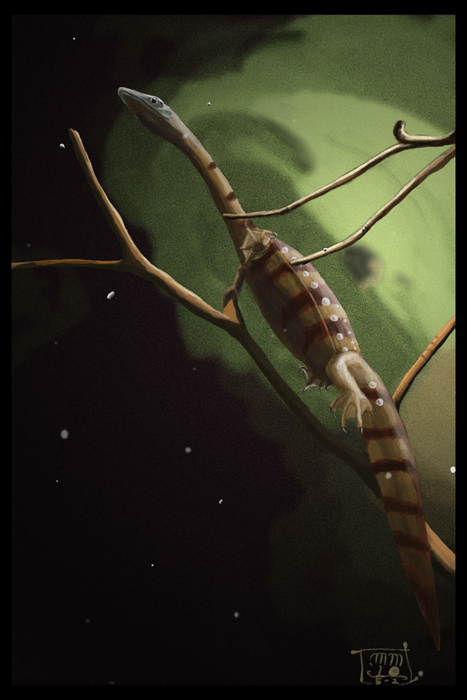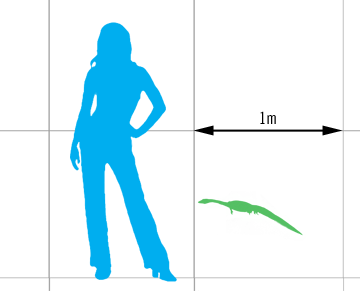home > natural history
Hyphalosaurus lingyuanensis
"Lingyuan submerged lizard"

Click here to buy a print
Hyphalosaurus lingyuanensis is an unusual reptile even among its peers. The choristoderans are an enigmatic reptile group, in the sense that nobody can quite figure out what they are. Their anatomy is a mixture between archosaurian (crocodiles and dinosaurs) and lepidosaurian (lizards and snakes). Outwardly, many of them looked superficially like crocodiles, with short necks and long, tapered snouts.
The discovery of Hyphalosaurus, however, added a new twist. Rather than a traditional choristoderan, Hyphalosaurus looked like a miniature plesiosaur, with a long neck, small, flat head and a long tail. It's close relative Hyphalosaurus baitaigouensis is the most common tetrapod in the Jehol biota, known from thousands of specimens. As a result, Hyphalosaurus is extremely well known. The life of a Hyphalosaurus started in a soft-shelled egg inside the mother's reproductive system. Inside the womb, eggs were arranged in pairs, and the shell eventually was re-absorbed by the mother, leaving the young to be born alive tail-first (assuming a breech, head-first birth didn't stop the process and kill the mother, as shown in one specimen).
Tiny newborns were then left to fend for themselves, not an easy job in lakes filled with fish and predatory wading birds like Hongshanornis and Longicrusavis. Some seem to have been doomed from the start, including one specimen of a newborn with polycephaly (a rare mutation sometimes seen in modern lizards and snakes where an individual is born with two heads), the earliest known example of the deformity in the fossil record.
Hyphalosaurus probably fed on small fish like the contemporary Lycoptera at least occasionally, and one specimen shows fish ribs in the stomach. However, the vast majority of specimens don't preserve any gut contents, which is odd considering the enormous sample size. It's possible that Hyphalosaurus preferred soft-bodied prey that are difficult to fossilize, such as insects and their larvae or immature crustaceans like those of the large freshwater shrimp Liaoningogriphus, with which it shared it's lake bottom habitat. The long neck, small head, and small, simple, needle-like teeth of Hyphalosaurus indicate that unlike the more crocodilian-looking choristoderans, it was not an ambush predator. It was probably more active, pursuing small prey in bursts of swimming propelled by its tall, flattened tail (the tall neural spines of the tail vertebrae were extended by an even larger soft tissue fin). Like modern aquatic reptiles such as turtles, it probably attacked with a quick sideways swipe of its neck.
Hyphalosaurus was first described in 1999, based on a specimen found by private collectors.
In an odd twist, two teams of scientists from separate museums in Beijing both received a different slab of the exact same specimen. They described and named the specimen independently, even choosing the same species name (lingyuanensis). Both descriptions were published within days of each other in January 1999. One team named the genus Hyphalosaurus, the other Sinohydrosaurus (or "Chinese water lizard"). Because these names are based not on similar specimens but the exact same specimen, they are objective (rather than the usual subjective) synonyms--no argument can be made that they represent different species or subspecies because they're based on the same individual animal. Unfortunately, there was no corroborating publication to show which of these twin names was born first. Under such circumstances, the ICZN mandates that someone act as first reviser and arbitrarily choose which name should have priority. Smith and Harris did so in 2001, noting that the manuscript version of the paper naming Hyphalosaurus was submitted, though not necessarily published, first. Based on this they decided that Hyphalosaurus should have priority, a decision that has been accepted by all subsequent researchers.
Image Details:
Media: Graphite, digital coloring in Adobe Photoshop CS3
License:
ALL RIGHTS RESERVED
DESCRIPTION
Length: 70cm (2.2ft)
Weight: no estimate
Location: Yixian Formation, Liaoning, China
Time: Aptian age, Early Cretaceous (124-123 Ma)
CLASSIFICATION
Kingdom: Animalia
Phylum: Chordata
Class: Stem-Reptilia
Order: Choristodera
Family: Hyphalosauridae
Genus: Hyphalosaurus
Species: H. lingyuanensis
SYSTEMATICS
Sauropsida
Diapsida
Lepidosauromorpha
Choristodera
Hyphalosauridae

Scale chart, size based on holotype specimen
Hyphalosaurus lingyuanensis (click to enlarge)
